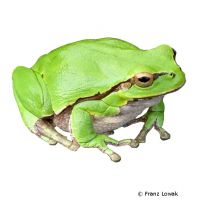Australian Green Treefrog (Litoria caerulea)
| Australian Green Treefrog Litoria caerulea | |
|---|---|
| Name | Australian Green Treefrog |
| Name Lat. | Litoria caerulea |
| Synonym | Ranoidea caerulea |
| Family | Hylids |
| Family lat. | Hylidae |
| Order | Frogs & Toads |
| Order lat. | Anura |
| Origin | Australia |
| Habitat | Humid savanna |
| Diet | Small live insects |
| Humidity | 70-100 % |
| Behavior | Peaceful, nocturnal |
| Keeping | Pair, group |
| Care Level | Easy |
| Breeding | Moderately difficult |
| Housing | Humid terrarium |
| Life Span | 10-20 years |
| Protection | No |
| Metric Units | |
| Size | 13 cm |
| Temperature | 22-30 °C |
| Housing Size | 40 x 40 x 60 cm |
| US Units | |
| Size | 5" |
| Temperature | 72-86 °F |
| Housing Size | 15" x 15" x 25" |
Distribution and habitat
Primarily crepuscular and nocturnal, ground- and tree-dwelling, Australian coral-fingered tree frogs are native to New Guinea and northern and eastern Australia. They inhabit woodland and scrub areas near water bodies as well as marshy grasslands. As cultivators, they also live near watering places on and in houses.
Maintenance
For 1-2 animals, the minimum area of the terrarium is 1,600 cm² with a minimum effective height (measured without substrate) of 50 cm. This corresponds to a base area of e.g. 40 x 40 cm. For each additional animal, an additional 500 cm² area and 3 cm height must be provided. The terrarium should be placed in a quiet place without sunlight.
You need a terrarium (aquaterrarium) with a substrate of loose, absorbent, non-rotting substrate such as sand-peat mixture, coconut fibers or sphagnum moss with a drainage, in addition pieces of bark, flat stones, strongly branched climbing branches, preferably entwined by climbing plants, a dense planting (e.g. Tradescantia, Ficus, Hoya, Bromeliads) and a shallow water basin. Potted plants that can be easily removed for cleaning are advantageous. At least twice a day, except during seasonal dry periods, the inside of the terrarium must be finely sprayed with water (humidity), but a rain or mist system is better
| Temp. day: 22-30 °C | Temp. night: min. 21 °C | Humidity: 70-100 |
The lighting duration must be 10-14 hours depending on the season. Very suitable are daylight fluorescent tubes with low UV content, supplemented with spotlights.
During the seasonal dry period (3-5 months) the humidity is reduced to 50-80 %.
Diet
The food supply consists of live insects such as crickets, small grasshoppers and crickets, as well as mealybug larvae and cockroaches. After a period of habituation (feeding with tweezers), special ready-made food is often accepted as well. Food should be offered to adult animals 2-3 times per week, young animals must be fed daily. It is important to add minerals and vitamins regularly (e.g. by dusting the food animals).
A varied diet promotes health and prevents deficiency symptoms.
Reproduction and breeding
The throat of the females is whitish, that of the males yellowish and they have a sound bladder, which is recognizable as a fold on the throat.
They spawn in smallest waters up to 2,000 eggs in small clusters of 100-200. The larvae (tadpoles) initially filter microorganisms from the water, later eat animal and vegetable food, and grow up to 90 mm in size. After 38 days (at 30 °C) the transformation (metamorphosis) is completed and the frog leaves the water.
Important
Australian coral-fingered treefrogs must not be socialized with other species because of the toxicity of their skin secretions. They have a barking call and are very adept at climbing with their finger and toe tips widened into adhesive discs. Their mucous membrane is very sensitive, accordingly care must be taken to maintain the necessary humidity and maximum cleanliness.
Before purchase, a terrarium should be prepared that meets the species-specific needs. Necessary are good ventilation without drafts, as well as devices for measuring temperature and humidity. The lighting has to correspond to the species-specific day-night rhythm and should be placed in such a way that the animals cannot injure themselves. The terrarium should be locked in such a way that neither unauthorized persons can open it nor the animals can escape. Special attention must be paid to thorough hygiene and impurities must be removed regularly
Further literature can be found in your pet store.
References
Text: petdata; Image: Franz Lowak
Source: ENGELMANN (2006): Zootierhaltung - Tiere in menschlicher Obhut: Reptilien und Amphibien, Harri Deutsch Verlag; VDA & DGHT (2006): Haltungsrichtlinien für die Haltung von Anuren
- Gemäß § 21 Abs. 5 Tierschutzgesetz idgF
